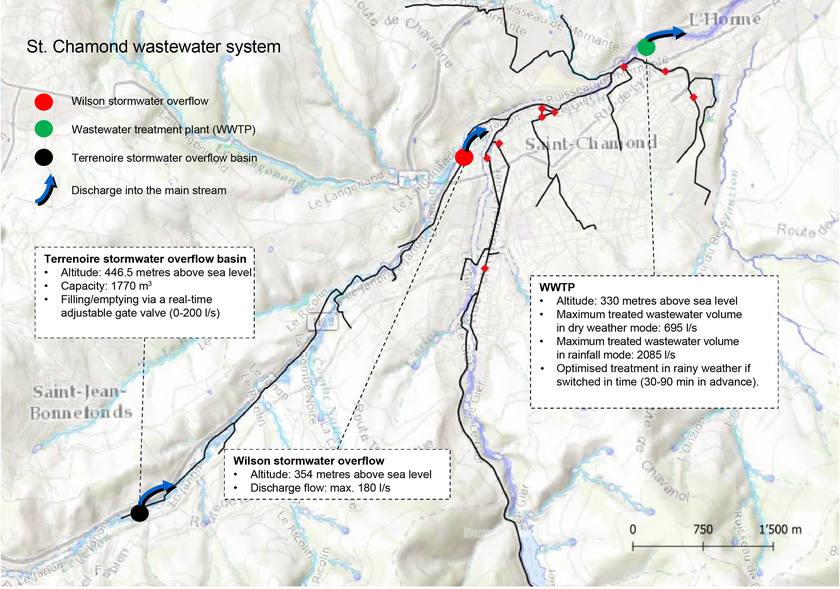Optimising wastewater management and protecting water bodies

Article from the Info Day Magazine 2022
Natural waters are regularly polluted by the discharge of wastewater from combined sewage systems. With the help of a “digital twin”, the management of wastewater systems can be improved and water pollution decisively reduced.
Chemicals, heavy metals, pathogens or micropollutants enter the sewage system from households and industry. If wastewater treatment plants do not remove the harmful substances from the water, they pollute our water ecosystems. In many urban and industrial areas, wastewater is mixed with rainwater in a combined sewage system and fed into a wastewater treatment plant. From there, the purified water is discharged into a nearby body of water. In urban areas, however, the combined sewage system sometimes reaches its limits. During heavy rainfall, so much water accumulates in a short time that it can no longer seep into the largely asphalted ground. It is therefore discharged via the sewage system to the wastewater treatment plant, which, however, only has a limited capacity. It the capacity is exceeded, the surplus, which is made up of wastewater and rainwater, is discharged untreated into the water bodies.
In order to catch run-off peaks and limit the discharge of wastewater into water bodies, combined sewage systems also consist of retention and spillway constructions. In addition to the wastewater treatment plant, such a wastewater system also includes stormwater basins and stormwater overflows. The stormwater basins collect the mixed runoff and store it temporarily, while the stormwater overflows discharge it directly into the water bodies. Such infrastructure with collectors, wastewater treatment plant and spillway constructions is complex and requires a high level of technical expertise for smooth operation. In view of population growth, municipalities face a major challenge if they want to further reduce water pollution. Climate change and the associated increase in extreme precipitation events make this challenge even greater.
On the way to dynamically managed wastewater systems
Many wastewater systems are managed statically: the stormwater basins and the stormwater overflows release water into the water bodies from fixed threshold values, regardless of the current weather conditions. If local weather measurements and forecasts were incorporated into dynamic management, the existing infrastructure could be operated much more efficiently and the pollution of water bodies reduced. The concept of the digital twin makes such dynamic management possible. The term “digital twin” comes from the world of communication. In such a system, the data measured in real time can be linked to the modelled system, allowing processes to be simulated and the model to be improved. This also allows the management of the real system to be optimised.
How can the concept of the digital twin be applied to the management of wastewater systems? First, the existing wastewater system (the original object) is replicated in a simulation model (the digital copy or twin). Subsequently, data from real-time measurements of wastewater and runoff flows as well as precipitation quantities are fed into the model to improve the management of the real system and optimise the dynamic management of the system. The simulation model is based on the software RS URBAN, an adaptation of the “Routing System” software that was originally developed at the EPFL. This simulation model makes it possible to combine hydrological and hydraulic modelling of urban systems with the modelling of natural catchment areas and rivers.
The digital twin of the St. Chamond wastewater system
The town of St. Chamond in the Loire region was one of the first municipalities in France to opt for the introduction of a digital twin to manage its wastewater systems. St. Chamond has 36,000 inhabitants and a large industrial area. The ground over 71 percent of the municipal area is sealed. The River Gier, which flows through the town, runs underground for long stretches before flowing into the Rhône at Givors. Its catchment area covers 403 square kilometres. The wastewater system at St. Chamond consists of a wastewater treatment plant (WWTP) and various spillway constructions. These include the Terrenoire stormwater overflow basin, the Wilson lateral stormwater overflow and other stormwater overflows that are not affected by the regulation of the stormwater overflow basin.
The company that operates the St. Chamond wastewater system, Veolia Eau France, commissioned the Swiss company Hydrique Ingénieurs to develop a digital twin of the system. This means that the operators can now dynamically manage their wastewater system by adapting it to the local weather conditions and wastewater production. Thus, the retention capacity of the Terrenoire stormwater overflow basin could be optimised and the regulation system of the wastewater treatment plant could be automated. Frédéric Jordan, the managing director of Hydrique Ingénieurs, is delighted by the result: “In 2020, we were able to reduce discharges of untreated water into the River Gier by 17 percent overall, and reduce discharges of suspended solids and ammonia (NH4) by 20 percent and 34 percent respectively. In 2021, discharges of untreated water were reduced by as much as 29 percent.” The first results were very promising. However, according to Frédéric Jordan, the potential for improvements is far from exhausted. Thanks to the digital tin, the existing infrastructure can be used more efficiently, as the model can be further improved by the local data measured in real time.
Links
Created by Manuela di Giulio for the Info Day Magazine 2022


